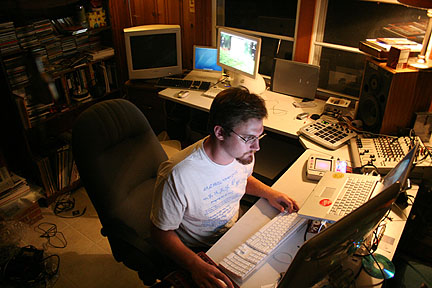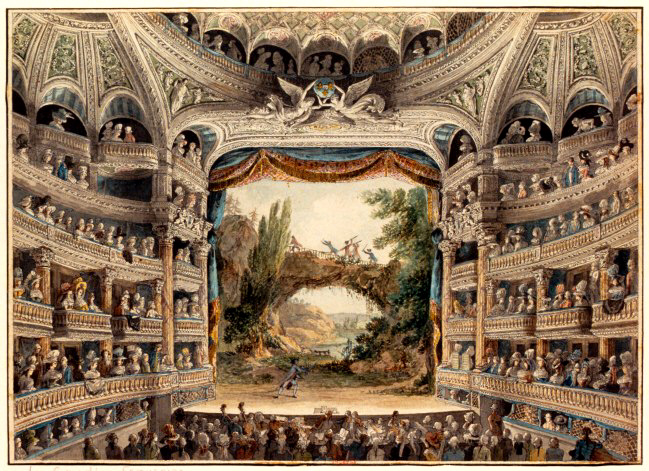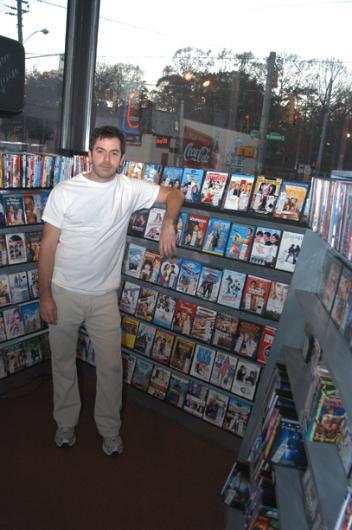As promised, I'm getting around to posting my better business ideas. Yes, yes. I'm sure your breath has been bated.
INTRO
Think of your favorite movie. Now imagine the ideal environment in which to watch it. Do you see yourself alone, in your underwear, in your own bedroom, late at night, watching your favorite movie on your computer monitor? Unless you're one of those rare individuals willing to argue the artistic and cultural merits of porn, it's not likely.
The future of porn? Maybe. The future of cinema? Don't count on it.
Probably you're thinking of a dark room with a huge screen and comfortable chairs. And, almost certainly, other people. Although the advent of forums like YouTube has fomented whole new genres of minimalist movies (e.g., machinima, video how-tos, porn vlogs, and even as yet un(sound)bitten political speeches), our thirst for full-length feature films appears unslaked. And we still prefer viewing them, when possible, in the company of other viewers. As an art form, film descends from theater, and the social dimension of theater is irreducible and ineradicable. Part of the meaning of watching theater--and therefore part of the meaning of watching films--is watching them as part of group.
Viscerally, we know this is true. Funny movies are funnier when viewed in a packed cinema. Scary movies are scarier. Exciting movies are more exciting. The whole experience of watching a film is intensified and improved when the house is full.
In a sense, "audience" is a role--a role it sucks to have to play by yourself.
OPPORTUNITY
Most current thinking about about how people are going to consume movies in the future, even the freshest, can be divided into models based on how people consume live theater on the one hand and how people consume internet pornography on the other. (There are some non-stupid "innovations" in the works which try to make the most of the cinema space, but they have little to do with the movie-going experience per se.) The theater model can't seem to get past the fact that plays are performances while films are recordings of performances--that is, they're what we call media. The porn model can't seem to get past the fact that watching anything except porn by yourself isn't nearly as much fun as watching it as part of an audience.
The most important development in the movie business during the past 20 years isn't--with all due respect to Peter Jackson and his fanboys--CGI, but the megaplex:
The improved viewing experience and the ability to let consumers watch whatever movie they wanted almost whenever they wanted brought more people through the door and bulked up Hollywood's grosses.I love this conceit--that access to 20 or 30 screens has allowed consumer to "watch whatever movie they wanted almost whenever they wanted." Whatever movie I want? Give me a break. And what about TV series, animated shorts, foreign releases, etc. etc. etc.? And rental stores? There are good reasons why they're dying out.

"Um.. Bollywood? The Thunderbirds? Fullmetal Alchemist? Le Dîner de cons? Nah, we don't got any of that. But, dude, have you seen The Transformers?"
Megaplexes offer an order of magnitude more choice than the 3-screen movie house; your average rental store (which carries some 3,000 titles according to Chris Andersen) ups the choice by two more orders of magnitude. And then Netflix and company bump that up to 60,000+ titles--another order of magnitude plus a doubling thrown in for good measure. No doubt that 30 screens offers a lot of choice, but it's still the film industry and the theater managers who decide what's on the menu. Time to break out.
THE IDEA
The challenge, I would argue, is to get The Long Tail of screenable media (i.e., movies, TV, video games, and a bunch of stuff I'm sure I'm missing) to interface elegantly with the social theater experience.
The Setting. So, imagine an urban megaplex which offers 30 screens of varying sizes--from the 300-person stadium to the 15-person black box. (I'm picking 15 as the minimum capacity because, in my experience anyways, 12 is the magic number where dinner party tips and becomes a house party.) However we manage it, our megaplex is technically capable of showing anything that's currently out on DVD on any of its screens. (I see two basic possibilities here: either (1) allow the viewers to bring their own media--you're just a screen and seat provider; or (2) go digital--maybe make ISO images of every DVD you can get your hands on, or an equivalent. I like (2) better for a variety of reasons, but (1) might be the place to start while the IP agreements get hammered out.)
Architecturally, the lobby resembles a cafe more than a cattle yard. Picture a large space subtly divided by differences in floor height, floor coloring, lighting, etc. in order to create a cluster of distinct, yet interconnected spaces, each of which feels somewhat enclosed and therefore intimate. The idea is to provide environmental level support the social dimension of consuming screenable media. Film clubs, groups of friends, and/or couples can use this space to nosh and chat before and after movies.
The Website. The website of our megaplex looks more like a social networking website than a tarted-up broadsheet for the very simply reason that it is a social networking site. The website is the platform which our megaplex uses to decide--on a rolling, ongoing basis--what it's going to show on each of its screens. Website members "vote" for a particular title and a particular time-slot by prepurchasing tickets to those titles at those times. (Credit card authorization--not charged until movie is shown.) The most popular title for any given time-slot is shown in the biggest theater, the second most popular in the second biggest screen, and so on. Titles are "locked in" 48 hours in advance in order to allow everyone to plan their schedules and casual viewers to pick what they want.
One interesting consequence of this system is that it becomes possible to distribute various screens over several different physical locations within a city. Not too many different locations, or people would get confused. But a single web system could link together a handful of physical clusters of screens into a single movie selection and viewing system, effectively allowing our megaplex to consume urban real estate much more efficiently. We can therefore offer 100 screens' worth of choice without thereby incurring a need for a gargantuan, unbroken chunk of real estate. In fact, precisely the opposite. The more geographically concentrated our demand (the more "urban"), the more screens we can offer. And further, since every theater is filled to capacity (or as close as we can get) every time, we optimize our use of square footage even further.
Show Me the Money. Our megaplex will pass profits back to those who own the rights to the media on a per-seat-sold basis rather than a per-showing basis. This has several consequences.
First, pricing for the viewer is dynamic. The more "votes" a suggested title-and-time gets, the cheaper the tickets. This displaces some of the responsibility (and risk!) of promoting a particular title-and-time onto its supporters. A film club working its way through all of Humphrey Bogart's films, for example, will not only form the core of the audience which views those films--they'll also promote those title-and-times to everyone else. Take this line of thinking to its logical conclusion, and you've got individual promoters buying out entire screens and promoting film events (say, a Star Wars-a-thon) on their own. The promoters shoulder the risk of promotion; the audience gets a full house experience; and our megaplex gets a locked-in profit on an optimized use of cinema square footage. Every title which gets shown in our megaplex has, before it shows, demonstrated that it can command such-and-such level of committed demand.
Second, pricing between our megaplex and media rights owners is negotiable on a title-by-title basis--even on a showing-by-showing basis--because our megaplex can show exactly how many seats are sold for each title. Structurally, such a system will favor older titles (whose production costs have already been either recouped or written off), niche titles (which capture focused, sustained affection), and less publicized titles (which have fewer advertising costs built into their financing model). Basically, although our megaplex is perfectly capable of competing with "normal" theaters when it comes to blockbusters, it's capable of making gold out the vast libraries of screenable media currently lying around in our culture.
And third, this system really opens up the possibilities for using a cinema-like space in creative ways. Business presentations? Naturally. Ungodly-huge-screen Super Smash Bros. Brawl parties? No problem. Anime marathons? Duh. In a way, this model is a bit like McDonald's:
The brilliance behind Harry Sonnenborne’s model [for McDonald's] was to sell real estate and not hamburgers. His suggestion was to purchase or lease the land on which all the McDonald’s restaurants were built on. Franchisees would then pay the company either a monthly rent amount or a percentage of their gross sales, whichever amount was greater.The idea isn't to sell movies (which today's theaters can't do, so they sell outrageously priced corn syrup instead) , it's to rent square footage, facilities, and equipment to those in a position to use those resources to their utmost. Why be a lousy movie promoter or a gouging snack-food vendor when you can be a fantastic screenable media landlord? Let the watchers be the deciders, because those who decide what to show bear the risk for promoting it.
AFTERWORD
There are plenty of holes here, so please, comment away.